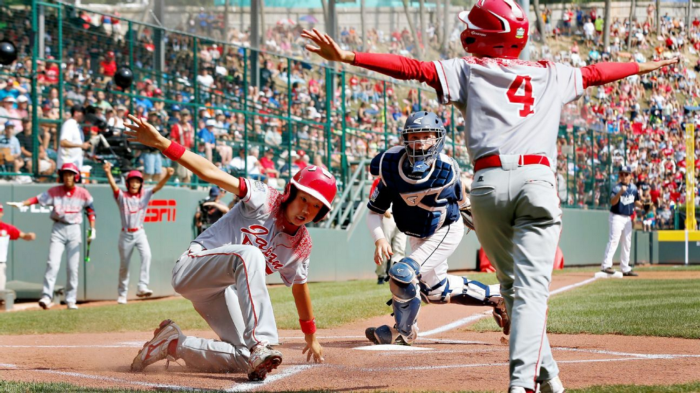

As the famous sports saying goes, “There is no “I” in “TEAM”. Just like in sports, rarely can one person single handedly and skillfully run everything in a business. I can now say that coaching a baseball team is like running a business. And I should know: I was the proud coach of a Hong Kong Little League (HKLL) team, the TTBC Eagles, during a very challenging and COVID-19 wrought 2020–2021 season. Fortunately, our season ended in a triumphant story of redemption, but I think the real lessons learned on the field originated from my time running startups.

I’ll begin this story at the beginning of the baseball season. We had a kid who was by far the most talented player in our division; looking back, I confess that the whole team seemed built and managed around this player. We were off to a dominant start to the season. That is, until he and his family moved out of Hong Kong. This set off an unfortunate series of events (losses) that turned this group of youthful contenders to the bottom ranks at mid-season.
We needed a new plan.
1: Run your team not as a family, but a high performing sports team

Let me first state that the good folks at Little League baseball have designed the rules so everyone can participate, learn and enjoy the game and I am fully supportive. That said, when we lost our best player, our team bought in with the mission to turn our season around while I was entrusted with staying true to HKLL spirit of the rules.
I started to work individually on improving every single player — our team would only be as strong as our “weakest link”. I also prioritized playing time based on commitment and performance within practices. Everyone, especially my 11-year-old daughter, had to earn their game day positions. I told my team that if you don’t come to practice and perform, you don’t start or play key positions. The night before the games, I would review the last game results and past improvements at practice to determine our game plan the next day.
At a startup, your first employees may feel like family. They’re certainly close as they spend the lion’s share of time with you and are the first to join you on the mission. Don’t let this closeness tempt you to manage them as such.
Running your business should be like running a professional sports team.
Reed Hastings, founder of Netflix, famously echoed this sentiment in his 2009 presentation on company culture, saying “Coaches’ job at every level of Netflix [is] to hire, develop and cut smartly, so we have stars in every position.” The key to team success is to be aware of each individual’s strengths and weaknesses and optimize their abilities.
You are the coach and your direct reports are your athletes. Get them trained and ready for competition.
2: Let them play — do not micromanage
I remind my kids that I literally cannot bat for them, pitch for them or play defense for them. I can only teach them how to do it themselves and recognize situations and patterns.
As a manager of a company, there is always a temptation to step in and do everything yourself. Instead, allow your team to learn and execute themselves. Your job is to teach, coach and foster the right mindset with the goal of reproducing excellence.
If X happens, then do Y.
For companies and baseball teams alike, especially, pattern recognition is an important concept for growth. As Nate Silver writes in his book, The Signal and the Noise: Why So Many Predictions Fail-but Some Don’t, “the signal is the truth. The noise is what distracts us from the truth.” On the field, this can manifest in a more physical form, as my kids need to recognize signals (away from the noise) and execute. In the workplace, we sit down in our weekly meetings and identify key signals in our metrics. X went down or Y went up. Why? At our startup, we propose certain hypotheses and the next set of actions to test and confirm.
When you make mistakes, which will happen, run a post mortem and use it as a teaching opportunity to remind them what they’ve learned. With each mounting loss, I asked our kids to volunteer answers on “what did we learn”. We went around the team and kid after kid would volunteer an answer which turned into a practice plan for the next training session. Sometimes at our startup, we operate at warp speed but it’s important to also pause and work with your team to identify the root causes to these results and come up with a plan.
3: Work hard, “Have a Plan” but Know the Situation
“If you know the enemy and know yourself, you need not fear the result of a hundred battles.”
Sun Szu, The Art of War
Managers need to find ways to motivate employees, just like baseball players, to execute continuously at high levels. In both cases, competition can be a great driving factor. Cultivate and drive work ethic on your team by reminding them that somewhere, right now, there are other teams out there working just as hard to beat you, whether on the scoreboard or by gaining market share. In order to achieve a competitive edge, it’s important to “practice like you play”. Every task, no matter how seemingly menial or insignificant, has a purpose and part of a larger picture.
I taught my kids, especially our “rookies”, about having a plan when they are on offense. For those who understand baseball, it is important to recognize what is a “good” ball to swing at (a strike) and what is a “bad” ball to not swing at (a ball). To avoid turning this into a baseball coaching article, we essentially had our players continually go through drills to recognize the difference. On game day, I would remind each player to “have a plan” of attack.
Confession time: I have to admit, I ended up as one of those youth baseball coaches who would study my upcoming opponent, review their statistics, last game results and speak to other coaches who faced them.

My time at Uber has taught me a thing or two about studying, anticipating and preparing for the competition around the world. This extends into my current startup. We were inspired by a lot of our peers, but have also learned where the opportunities lay. Study your competition.
“Kids, how many outs? What are you going to do if the ball comes to you?”
Creating scenarios in which you ask your team what they will do if something happens can better prepare them for that moment. Baseball is a sport which requires situational awareness, there are times to pause and consider different tactics for every situation. I would constantly train the kids to recognize the situation and apply the appropriate strategy. Leadership experts Paul Hersey and Ken Blanchard developed the situational leadership model in their 1969 best-selling book, Management of Organizational Behavior: Utilizing Human Resources. Blanchard and Hersey are well known for the situational leadership theory, which requires leaders to ensure companies are nimble and have a keen understanding of when to change depending on the business scenario — the situation.
At my company, we have extended this situational awareness in the form of buyer personas and use cases. Specifically, knowing who are your target customers and the exact use cases have helped shape our user acquisition strategy.
5: Take ownership and do the right thing — everyone is watching
As a coach, my kids are always taking a lead from my own actions and words. I’ve learned through good times and especially the bad, that keeping your cool and taking ownership is paramount in a leader. It’s easy to lose it on the field or in the office when something doesn’t go your way. I tell my kids that the worst thing you can do is to blame others. Own your mistakes and learn from them. We lost a string of games after losing our star player and it would have been very easy to give up or create a culture of blame for the rest of the season, but we didn’t.
We faced games where officiators may have had “eyesight problems”. Umpires will make calls that won’t go your way and are completely out of your control. Your team may complain to you about this, but as a leader, you should listen, and not whine back. In one instance, I was very upset, but kept my composure and taught the kids to own up to the outcome of the game.
Towards the end of the season we started to put things together and win again. The team was rebuilt, players improved and our reconstructed team was as solid as it ever was.

I remember one of our first big wins in the 2nd half of the season. Our team was very excited but I also taught them the virtue of winning with class. I reminded them that “your competitors wanted to win as much as you did” and how it felt when we were on the losing side.
In Ben Horowitz’s book, What You Do Is Who You Are: How To Create Your Business Culture, the Andreessen Horowitz partner suggests a holistic view to understand your true company culture.
“Who you are is not the values you list on the wall. It’s not what you say in company-wide meetings. It’s not your marketing campaign. It’s not even what you believe. Who you are is what you do.”
Everyone, including kids and their parents, observes how you react to adversity. Keep your cool and do the right thing. Your actions define your culture.
6: Optimistic Leadership, Recognize Wins and Be Inclusive
“Hope springs eternal in the human breast: Man never is, but always to be blest.” Alexander Pope, An Essay on Man
“Hope springs eternal” is also what we say at the annual start of the baseball season every year. There is this romantic optimism around the sport of baseball that extends beyond the trials and tribulations of each season. This mindset also extends beyond the baseball diamond and into the workplace. It’s important to stay positive and avoid creating negative environments. If you do criticize, apply with teachings of improvement.
I’m hard on my kids (and my work team), but I focus on optimistic leadership. Often at the moment of maximum stress during the game, if one of my players was struggling, I would lay out the worst case situation, which wasn’t that bad, and encourage them to not give up. At that moment, there was no need to criticize — it’s about getting it done and finishing well. As a manager, it’s important to let your team know that no matter what adversity they face, we face it together.
Another thing we implemented during this baseball season, despite all our adversities, was to celebrate wins. We awarded a game ball to a player each game and made sure every player received it at some point for different reasons. We looked for opportunities to award team members based on their performance.

In the workplace, we often do not take the time to celebrate wins or the contributions of our team. Individual and team awards can be a great team building activity and contribute to the company culture as well. In the past we used these awards to be inclusive and celebrate the diversity of our collective skill sets, rather than focused on one or two star employees.
End of the season
These principles helped me overcome the departure of my most talented player early in the season. With my star player gone, I had to pivot my entire team strategy and develop other players to replace him, a la Moneyball, statistically.
Our losing streak lasted well into the season and decimated our chances, but with the learnings, a plan and hard work, we were able to win the lower division championship with one of our most improved players as starting pitcher. I can say from experience that while there can be some crying in baseball, there can also be a whole lot of laughter too.